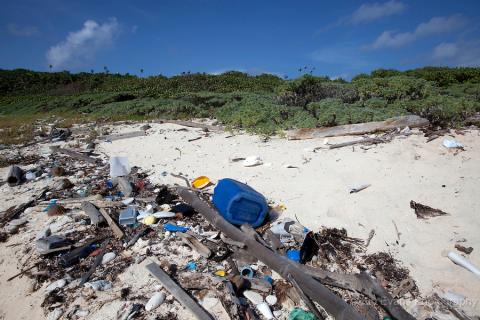Anticipation has repeatedly turned into frustration in the search for signs of Flight 370 as objects spotted from planes in a new search area west of Australia have turned out to be garbage. It's a time-wasting distraction for air and sea crews searching for debris from the Malaysia Airlines flight that vanished March 8.
It also points to wider problems in the world's oceans.
"The ocean is like a plastic soup, bulked up with the croutons of these larger items," said Los Angeles captain Charles Moore, an environmental advocate credited with bringing attention to an ocean gyre between Hawaii and California known as the Great Pacific Garbage Patch, which by some accounts is about the size of Texas.
The world's oceans have four more of these flotsam-collecting vortexes, Moore said, and the searchers, in an area about 1,150 miles west of Perth, have stumbled onto the eastern edge of a gyre in the Indian Ocean.
"It's like a toilet bowl that swirls but doesn't flush," said Moore.
The garbage patches are nothing like a typical city dump. In fact, most of the trash can't even be seen: it's composed of tiny bits of plastic bobbing just below the surface.
The larger items also tend to be plastic and are often fishing-related, Moore said, although he has come across light bulbs, a toilet seat, and, bobbing off the California coast, a refrigerator, complete with defrosted orange juice.
Seattle oceanographer Curtis Ebbesmeyer has been studying the phenomena of ocean debris for years. He said there are smaller collections of garbage within the gyres.
"If you go into a house you'll find dust bunnies," he said. "The ocean has a mass of dust bunnies, each moving about 10 miles a day."
Ebbesmeyer said he's fascinated by what happens to the trash that spews from the hundreds of shipping containers lost overboard from cargo ships each year. He said there's one that keeps belching out Lego pieces onto the beaches of Cornwall, England. Another spilled 2,000 computer monitors. Another released thousands of pairs of Nike sneakers.
Sometimes, he said, the containers themselves can become hazards as they bob about for months, buoyed by plastic objects inside or the air trapped behind watertight doors.
Trash also gets into the ocean after being washed down rivers or swept up in tsunamis, Ebbesmeyer said.
Scientists are particularly worried about small and seemingly ubiquitous pieces of plastic that can be from shopping bags, plastic water bottles or other household items. Waves break the items up into smaller pieces.
Wing Cmdr. Andy Scott, of New Zealand's defense force, said the crew in a P-3 Orion scouring the ocean for Flight 370 on Saturday spotted about 70 objects in four hours.
Three were deemed worthy of further investigation, he said, but none turned out to be from the missing plane. One was probably a fishing line, he said, another was a suspected icebox lid and a third was some unidentified brown and orange material.
A cluster of orange-colored items spotted on Sunday from an Australian search plane and thought to be a promising lead also turned out to be fishing equipment.
With garbage complicating an already fraught effort to find flight wreckage, Australia's Prime Minister Tony Abbott — elected late last year — said on Monday that the search is nowhere near over.
"I'm certainly not putting a time limit on it," Abbott told the press at RAAF Pearce, the Perth military base coordinating the operation, "We can keep searching for quite some time to come."


Spread the word